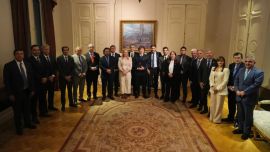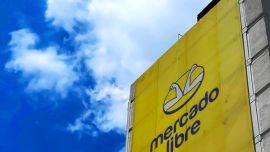Argentina’s government is to repatriate an old cargo plane used during the 1976-1983 military dictatorship to fly illegally detained prisoners to their death.
The Skyvan PA-51 aircraft, which was used on the so-called "death flights” during which detainees were tossed from great heights alive into the sea, has been found in the United States. It will be repatriated to Argentina for exhibition at the former ESMA Navy Mechanics School detention centre (now a human rights museum) in the next coming weeks, according to a report by Página/12 journalist Luciana Bertoia.
The plane’s most infamous journey took place on on December 14, 1977. On that day, three members of the Madres de Plaza de Mayo human rights group – Azucena Villaflor, María Ponce de Bianco and Esther Ballestrino de Careaga – as well as French nuns Alice Domon and Léonie Duquet were tortured, sedated and finally forced into the small plane and flown up in the air. Their captors then threw them into the sea and to their death.
The Skyvan PA-51 is only one of the notorious "death flights" aircrafts used by the military junta to dispose of the illegally detained and disappeared. If all goes to plane, government officials hope to have the aircraft on display by by Memory Day, March 24, at the ex-ESMA, “the place where it belongs to be part of Argentine history," Villaflor’s daughter Cecilia de Vicenti told the Página/12 newspaper.
Repatriation of the plane comes after years of efforts to track the long, multi-continental history of the plane led by relatives of the murdered Madres de Plaza de Mayo, journalists, and Argentine government officials.
The plane was formally identified on January 8, when pilot Enrique Piñeyro arrived at an Arizona airport to confirm whether the Skyvan aircraft had the same N190WW licence as the plane used during the "death flights."
"I went to corroborate that it was the same aeroplane. I’d seen it when at Fort Lauderdale and [Economy Minister Sergio] Massa asked me to verify that it was the same aircraft, very simple because I know the plane and the serial number never changes," the pilot and filmmaker told Página/12, explaining the request made by the minister following appeals from members of the Madres de Plaza de Mayo human rights group.
In 1971, the Argentine Coast Guard (Prefectura) purchased five Skyvan planes from Irish manufacturers. Two were destroyed during the Malvinas (Falklands) war while the other three were sold in 1994 to CAE Aviation SRL in Luxembourg. One stayed there, another ended up in Britain and the third went to the United States. When in 2010 the journalist Miriam Lewin and the photographer Giancarlo Ceraudo found the model in question, it belonged to the GB Airlink company, which used it as a private mail courier. Afterwards it was acquired by Win Win Aviation, which used it for parachuting.
Piñeyro revealed conflicted feelings in his conversation with Página/12, referencing the plane’s current use.
"Now it does parachute jumps. It’s a bit weird. It reminded me a lot of when I went to testify – the court and all the lawyers of the accused were hostile. At one point a female defence lawyer told me: 'You question the purpose of the flight, what would you say if I told you that it was for parachute jumps.?' I told her: 'I would first ask if the parachutists had parachutes.’ I couldn’t believe that they would say that to me at a court hearing."
Tossed from the air
Villaflor, Ponce de Bianco and Ballestrino joined the Madres in April, 1977, habitually meeting in the Santa Cruz church in the San Cristóbal neighbourhood, establishing ties of solidarity with relatives seeking to know what happened to their loved ones.
One of the group’s objectives was to raise funds for a paid advertisement demanding answers from Argentine authorities as to the fate of their sons and daughters who had gone missing under the dictatorship. The group also included other militants and clergy, including the French nuns Léonie Duquet and Alice Domon, who were connected to human rights groups and social organisations.
On December 8, a military taskforce abducted Ballestrino and Ponce de Bianco at the parish, together with other militants as well as the two French nuns. They were abducted as part of a naval operation led by Alfredo Astiz, a member of ESMA Task Force 3.3.2 who had infiltrated the human rights activists by pretending to be the brother of a victim, identifying himself as 'Gustavo Niño.’ After the dictatorship fell, he became known across the country for his cruel strategy: hugging or kissing people in order to mark them to the paramilitary groups as victims to be abducted.
"We killed some of them in shoot-outs but I don’t know what happened to the others, I handed them over alive… They told me: ‘Go and look for such and such,’ so I went and brought them in. Dead or alive, I left them at ESMA and moved onto the next operation," Astiz said.
On December 10 of that year, Astiz kissed the women who would later be abducted by Task Force 3.3.2 at the church door : Villaflor, Ballestrino and Ponce.
Detained and tortured at ESMA, they were eventually hurled alive into the ocean.
‘Death Flights’
Tortured at ESMA, as later revealed by survivors, the dozen victims were “transferred” on December 14, 1977 to an aircraft that would drop them to their death.
Just how many of those who went missing during the military dictatorship were killed in this manner is unknown. Many of the bodies that fell in the sea couldn’t be recovered or identified because the altitude of the plane was so high that it was equivalent to being thrown onto cement. Many of the bodies disintegrated in the sea within a few days. Others were washed up by the waters onto nearby shores.
In a 1998 television interview, formal naval officer Adolfo Scilingo gave a hint as to the regularity of the murder machine.
"Every Wednesday there was a flight and different officers were designated in rotation to take charge of them so that as many naval officers as possible were involved in those flights,” he said. “Those who had been chosen to die were taken to the airport doped with a light dose of sedative and fooled into thinking that they were being flown to a Patagonian prison. Then they were given a very potent second dose which knocked them out and were undressed. When the commander gave the order, they were hurled into the sea one-by-one."
On December 20 the corpses of the three Madres, Ángela Aguad and the nun Léonie washed up on the coast near Santa Teresita. They were buried in a common grave at General Lavalle cemetery until, in 2005, the work of the Argentine Forensic Anthropology Team (EAAF) identified their remains.
Honouring the victims
The effort to repatriate the aircraft – spearheaded by human rights activists Taty Almeida, Mabel Careaga, de Vicenti and Héctor Francisetti, Mabel's husband –– dates back almost three years. The activists met with President Alberto Fernández and Economy Minister Sergio Massa, as well as government officials at the Defence Ministry and Justice & Human Rights Ministry.
While Massa arranged the funds to buy back the plane, the plane’s documentation was passed to Senator Oscar Parrilli and he took it to Vice-President Cristina Fernández de Kirchner, who threw her support behind the repatriation bid.
"I can only thank God for this: that this plane is here and that it is going to the ESMA museum," said Taty. "This is memory, it is the clear proof of what the genocides did to our dear Mothers and our children. It is also justice, because it is further proof to the deniers that everything we say is true.”



















Comments